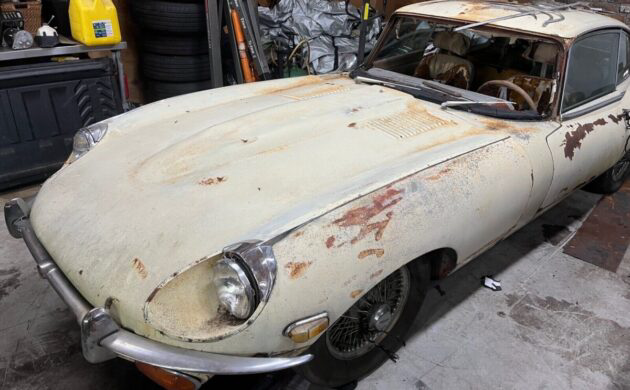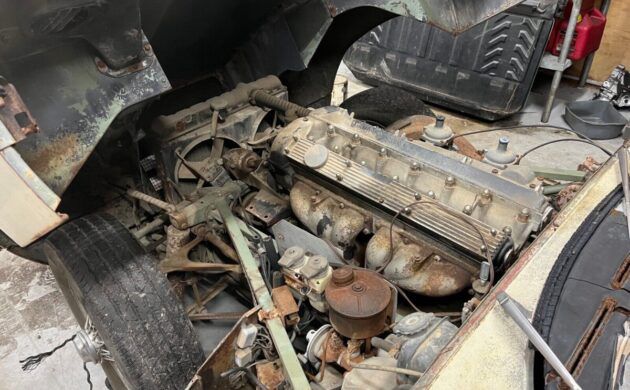Manual or Auto? 1970 Jaguar E-Type
Regular readers will know the Jaguar E-Type holds a special place in my heart. I believe it is one of the most beautiful cars in automotive history, especially in Roadster form. This 1970 2+2 Coupe brings an air of practicality to a classic British sports car, but its restoration stalled many years ago. The seller seeks a new owner willing to complete what others started, but they offer an intriguing option some may find impossible to resist. The Jaguar is listed here on eBay in Charleston, South Carolina. Bidding has passed the reserve to sit at $7,900, and I must say a big thank you to Barn Finder T.J. for spotting this British beauty.
The previous owner drove this Jag into a shop many years ago, planning on treating it to a repaint. It is unclear why, but the project stalled when the car was stripped and placed in primer. It recently emerged in its current state, but it could be stunning if returned to its former glory. The panels are straight, but the primer and surface corrosion leave little evidence of the car’s original Willow Green paint. The seller describes the shade as rare, but I cannot confirm specific numbers. The new owner faces stripping away the existing primer and surface corrosion to achieve a high-end finish, but it seems any existing rust could be relatively minor. The restoration means most chrome pieces require a trip to the platers, and although most of the glass is good, the buyer must source a replacement windshield. It sounds daunting so far, but it is worth remembering that whipping the panels and paint into shape will be no more complicated than for any classic from this era.
It would be fair to describe the Jaguar’s engine as quite conservative compared to high-performance American cars from the same era. Still, the car’s strength is that it utilizes what is available effectively. Its 4.2-liter DOHC six produces 246hp, and when coupled to the three-speed automatic we find in this E-Type, it launches the car through the ¼-mile in 16.5 seconds on the way to 140mph. The seller says this car drove into the paint shop, which is the last time it fired a shot in anger. It is unclear whether the motor turns, but revival might be possible if it does. There is an option that some buyers might find irresistible. The seller includes a healthy four-speed manual transmission, allowing the buyer to perform a conversion. That would make the car more engaging to drive and unlock worthwhile performance improvements. The ¼-mile ET would drop to 15.5 seconds while the top speed would increase slightly to 142mph. I generally favor originality, but I would find this idea pretty tempting.
One of the more expensive aspects of this build could be the interior restoration. It requires a total retrim, and while kits are readily available, high-quality ones will lighten the buyer’s wallet by nearly $5,000. That is hardly pocket change, but the result and potential vehicle value could justify the expense. It appears any removed items are floating around inside this classic, and most of the plastic should respond positively to cleaning. The original owner ordered this British beauty with air conditioning for those craving comfort.
The Jaguar E-Type is a long-term favorite in the classic world, and spotless examples can achieve some eye-watering sales figures. This one needs work, but if the bidding stays close to its current level, it could be one of the cheapest complete E-Type projects you will find in the current market. Tackling the build won’t be easy, and it will require commitment. However, the parts required are available, and the finished product should be an appreciating asset. The big question is whether you would complete the work faithfully or would the transmission swap prove irresistible.
Auctions Ending Soon
 2006 Ford Mustang Saleen S281 SCBid Now9 hours$15,000
2006 Ford Mustang Saleen S281 SCBid Now9 hours$15,000
 2002 Subaru Impreza WRXBid Now3 days$333
2002 Subaru Impreza WRXBid Now3 days$333
 1975 Chevrolet Corvette ConvertibleBid Now3 days$3,000
1975 Chevrolet Corvette ConvertibleBid Now3 days$3,000
 1964 Ford F-100 Camper CustomBid Now3 days$2,000
1964 Ford F-100 Camper CustomBid Now3 days$2,000
 2006 Jeep Wrangler SportBid Now5 days$10,500
2006 Jeep Wrangler SportBid Now5 days$10,500






Comments
Loves me a 2+2. So long and sleek.
If the underside isn’t rusted away and the price stays low this is a good one to restore. Do have to wonder if the seller is related to the guy selling the ’46 Ford though.
This ticks all the right boxes – Open headlights, Twin Solex carbs, Automatic, AC, 2+2, low compression engine – under Least Desireable E Type. That being said, if the bottom isn’t rusted out and the engine turns over, it’s an opportunity for a rebirth. Rebuild the engine, which is a 7.5:1 specification, with 9:1 pistons, fast road cams, and triple SU’s from an earlier car. Ditch both transmissions for a 5 speed with overdrive. New vented rotors all around, 4 pot calipers on the front. Polyurethane suspension points throughout and adjustable shocks. Keep the AC and modernize it, because the cabin will get warm at the speeds you’re driving.
Crap. I just may have talked myself into it.
RichardinMaine: Whether the motor has the 9:1 or 7.9:1 will depend on whether it is an early ’70 or a latter ’70. That can be determined by the engine number. If it ends in a 9 it has the 9:1. If a 9:1 the performance will be decent already, because it has been given earlier exhaust manifolds with the over-the-engine pipe to warm the fuel mixture, removed. With this done, the twin Zenith-Strombergs actually do the job of the triple SUs…contrary to what most people think. They atomize the fuel a lot more finely than the triple SUs. Combined with a more aggressive distributor that zaps that more finely atomized emulsion, the twin Zenith-Strombergs do what the triple SUs do. When the engine gets hot, the Z-S carbs are thermostatic, unlike the SUs, and allow in all the extra oxygen required by the increase in temperature. As for the brakes, the Series two had considerably better brakes than the Series One. They were bigger, had switched to Girling from Dunlop and in the front the Series II E Type was the first car on the planet to get triple callipers.
I completely agree with RichardinMaine. It’s a 2+2 hence you would not rot in hell for doing a modest resto-mod to make it better. Stick with 100% Jaguar outside and interior. Make it a performance driver to offset the 2+2 stigma.
Is car still for sale ?
Laurence – great comments on the Strombergs. I got a wild hair once, found a pair of “2 inch” Z-S’s (hand made from a pair of 175CDSE – bored out and had 2″ SU butterflys in them) and put those on my 69 2+2 along with bypassing the pre-heat box (sleeved the opening from front to back with a cut brass tube). That, along with the 2.88 rear end gave me a top speed of 156. At that speed (I was there maybe 5-10 seconds) I thought the car was going to vibrate apart. Figured later it was the tires were not designed for that speed and were breaking down if I had remained there for much longer. People don’t realize the 2+2 is better balanced that the FHC or the OTS. The extra bit of curve in the roofline is much more areo as well. Look at airplane wings. Fat center has less resistance than a fat leading edge. It really too bad Jaguar didn’t homologate the 2+2 as well as the other two for SCCA. If I remember correctly, they did for FIA (Group 4 if I remember?)
Great project for an LS swap.